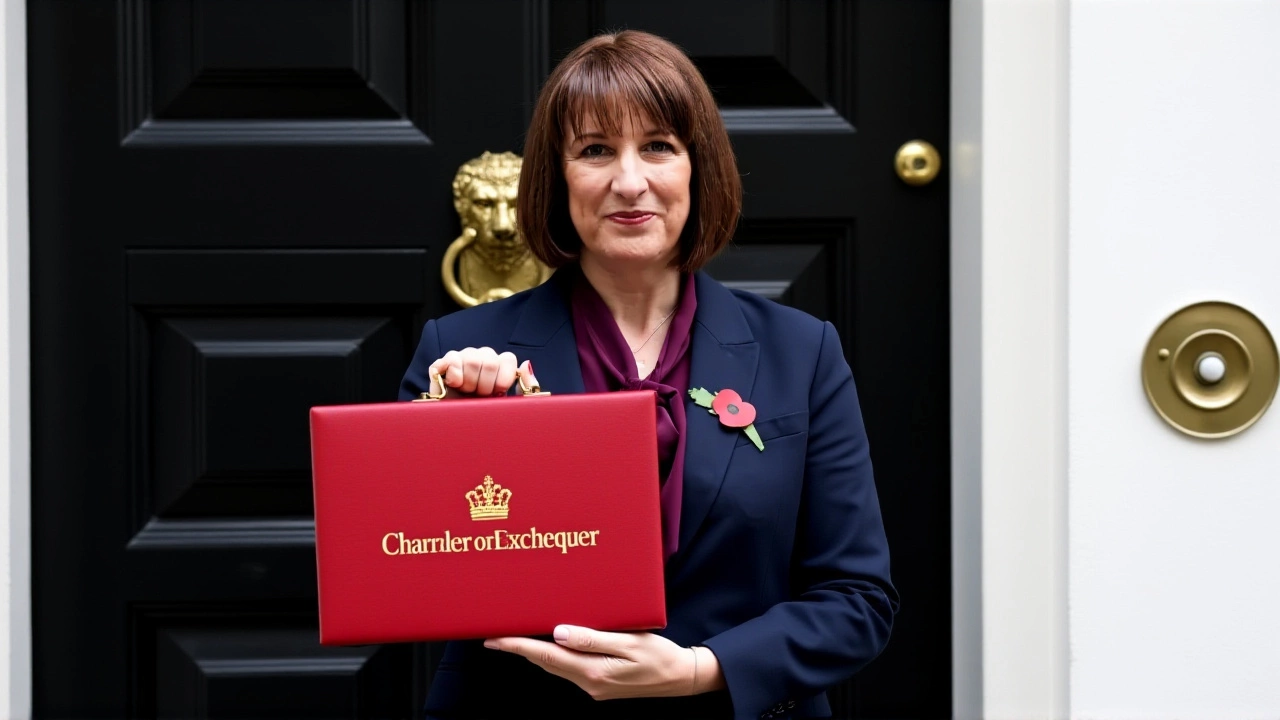The Autumn Budget 2025 didn’t just balance the books—it rewrote the rules. At precisely 12:35pm GMT on November 26, 2025, Rachel Reeves, the Chancellor of the Exchequer, stood at the despatch box in the House of Commons in London and announced a fiscal strategy built not on growth, but on restraint. The Office for Budget Responsibility (OBR) released its independent forecast just hours later, painting a sobering picture: a 0.1% demand boost in 2026, but no meaningful output gain by 2030. The message was clear: short-term pain for long-term stability.
Headroom Expanded, But at a Cost
The most startling number wasn’t a tax rate—it was the fiscal headroom. Raised from £10 billion to £22 billion, this buffer was Reeves’ answer to the brittle fiscal position inherited from previous governments. "We’ve been left with no margin for error," she said, echoing the OBR’s blunt assessment that past administrations had "drained the fiscal reservoir." The trade-off? A deeper squeeze on public services and households now, to avoid more drastic measures later. "It’s not a Budget of numbers," the OBR’s report declared. "It’s a Budget of choices: how thin a cushion, how bold a move, how balanced a mix?" PwC’s Paula Letorey confirmed the OBR’s upward revision of 2025 growth to 1.5%—a rebound from the 1% forecast earlier—but warned it was fueled by temporary factors, not structural strength. "We’re seeing a bounce, not a breakthrough," she said at 1:14pm GMT on Budget day. The real concern? Productivity remains stuck. Without it, wage growth can’t outpace inflation, and living standards stagnate.Tax Threshold Freezes: The Silent Tax Hike
No one’s raising income tax rates. Not officially. But here’s the twist: freezing thresholds is a stealth tax rise. With inflation still hovering around 3.2%, more workers are being pushed into higher brackets. Rachel Vahey of AJ Bell put it bluntly: "Over 8.3 million people are now paying higher or additional rate tax—up from 7.1 million just two years ago." That’s not a policy failure—it’s a feature. The Treasury knows it. The public is starting to feel it. Pensioners aren’t immune. The personal allowance freeze hits those over 65 earning modest pensions from part-time work or savings. "It’s not just the young," Vahey added. "It’s the retired teacher, the retired nurse—they’re paying more because the government didn’t adjust the numbers."ISA Cuts and the Wealth Tax Shadow
The most controversial move? Cutting the annual ISA allowance from £20,000 to £12,000. Bloomberg, citing government sources, reported the change is designed to redirect household savings into UK investments—specifically, into the Enterprise Investment Scheme (EIS) and Venture Capital Trust (VCT), both extended to incentivize risk-taking. But critics say it’s a forced trade: savings safety for unproven returns. And then there’s the elephant in the room: a wealth tax. While Downing Street insists it’s "not on the table," leaked briefings and expert analyses from Capital Economics and the Institute for Economic Affairs point to a £10 million asset threshold as the likely trigger. A mansion tax on properties over £2 million is also being floated. "These aren’t revenue generators—they’re deterrents," warned a senior tax partner at PwC. "If you’re a family with £15 million in assets and you know you’ll pay 2% annually, you don’t just sit still. You move assets. You emigrate. You stop investing."
Who Pays? Who Benefits?
The OBR’s analysis shows the burden falling hardest on the middle and upper-middle classes. The proposed cut to National Insurance exemptions for limited liability partnerships (LLPs) could hit doctors, lawyers, and tech founders—people who’ve structured their earnings to minimize tax. Meanwhile, the Quilter forecast of 1.2% GDP growth for both 2025 and 2026 suggests the economy is barely treading water. The government’s stated priorities—lowering the cost of living, slashing NHS waiting lists, cutting debt—are noble. But the tools being used? They’re blunt. Raising the national living wage for younger workers, as hinted in YouTube analyses, could price out entry-level jobs. Keeping energy policy rigid, despite falling global prices, keeps bills high and inflation stubborn.What’s Next? The Clock Is Ticking
The OBR’s five-year forecast shows debt peaking at 99% of GDP by 2029. Without productivity gains, the only way to close the gap is more tax or deeper cuts. The £22 billion headroom buys time—but not much. By 2027, the government will need to choose: raise taxes on housing, capital gains, or inheritance? Or slash health, education, or welfare spending? One thing’s certain: the next Budget won’t be about growth. It’ll be about triage.
Background: The Fiscal Tightrope
The UK’s fiscal position has been deteriorating since 2021. Public debt jumped from 80% to 96% of GDP under the previous administration. The OBR’s November 2025 report notes that the UK has the lowest fiscal headroom among G7 nations—just £10 billion before Reeves’ move. The £22 billion increase, while substantial, still leaves the UK with less breathing room than Germany or Canada. The 2023-24 fiscal year saw £15 billion in unallocated spending commitments. The 2024-25 deficit came in at £84 billion—£12 billion above forecasts. That’s why the Chancellor had to act. But her choices are constrained: no VAT hike, no income tax rise, no National Insurance increase. That leaves only two levers: tax base erosion (ISA cuts) and wealth redistribution (wealth tax, mansion tax).Expert Voices: The Warning Signs
"This isn’t fiscal responsibility—it’s fiscal delay," said Dr. Eleanor Moss, senior economist at the Centre for Economic Performance. "You can’t grow your way out of this without investment in skills, infrastructure, and innovation. Right now, you’re just postponing the reckoning." Meanwhile, the Institute for Economic Affairs argues the £30 billion deficit gap could have been narrowed by cutting employee National Insurance for those under £50,000—a measure that could have raised £10 billion without harming low-income workers. "The Chancellor chose political safety over economic logic," their November 25 analysis concluded.Frequently Asked Questions
How will cutting the ISA allowance affect ordinary savers?
The reduction from £20,000 to £12,000 means households will have £8,000 less in tax-free savings annually. For a basic-rate taxpayer, that’s roughly £1,600 in lost tax relief per year. While the government hopes this will push money into EIS and VCT schemes, those are high-risk investments—unsuitable for most retirees or conservative savers. Many will simply save less, reducing overall household financial resilience.
Why is the OBR so pessimistic about long-term growth?
The OBR’s central forecast assumes productivity growth will remain stuck at 0.7% annually through 2030—well below the 1.8% average of the 2000s. Without productivity gains, wage growth can’t outpace inflation, and living standards stagnate. The government has no major plan to boost skills, digital adoption, or R&D investment, which are the true engines of long-term growth.
Who will be most affected by the wealth tax proposals?
Those with assets above £10 million—roughly 15,000 households—would face an annual levy, likely between 1% and 2%. But the real impact may be on families with illiquid assets: farmers with land worth £12 million, entrepreneurs with private companies, or retirees with large property portfolios. Many may be forced to sell assets or take on debt to pay the tax, potentially triggering fire sales and market distortions.
Is there any chance the ISA cut will be reversed?
Unlikely in the short term. The £8,000 per household reduction is projected to raise £14 billion over five years—critical for funding NHS backlogs and debt reduction. Reversing it would require either new revenue (unlikely) or deeper cuts elsewhere (politically toxic). The government has framed this as a "patriotic savings shift," making reversal difficult without appearing to backtrack on fiscal discipline.
What does this mean for the housing market?
A mansion tax and higher capital gains taxes on second homes will likely cool demand among investors, especially in London and the South East. But with rental demand still 20% above supply, prices may not fall—rents will rise instead. Capital Economics warns this could push 300,000 more households into rental stress by 2027, worsening affordability for young workers and families.
Could the UK face a capital flight if wealth taxes are introduced?
Yes, and the signs are already there. Offshore financial centers reported a 17% surge in inquiries from UK high-net-worth individuals in Q3 2025. Switzerland, Portugal, and the UAE have actively courted UK investors with lower wealth taxes and residency incentives. If the tax is perceived as punitive rather than progressive, the UK risks losing not just capital, but the entrepreneurs and innovators who generate future tax revenue.
